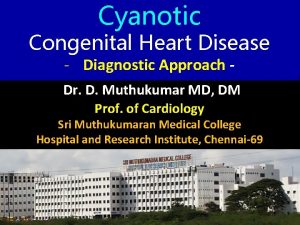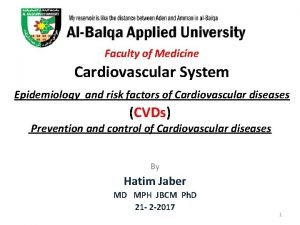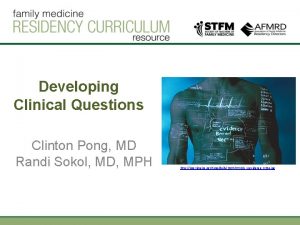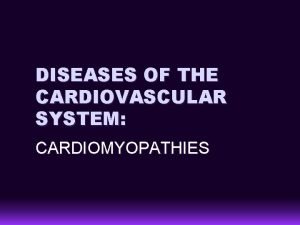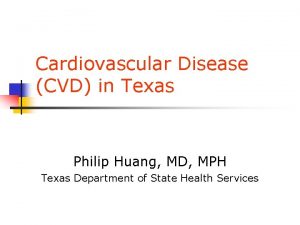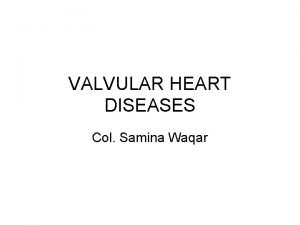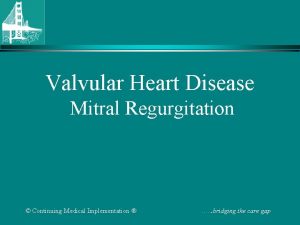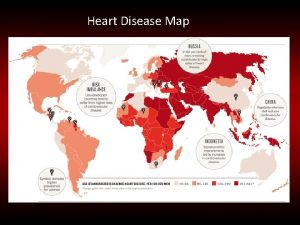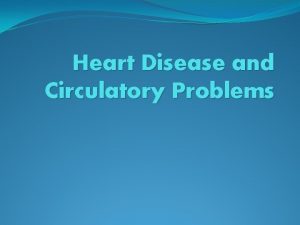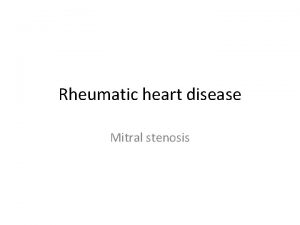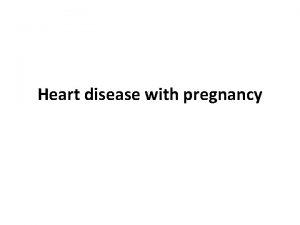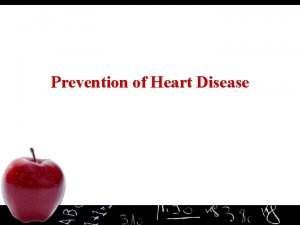The heart and heart disease 5 3 Heart











- Slides: 11

The heart and heart disease 5. 3 Heart disease – Risk factors

Learning outcomes Student should understand the following: �Risk factors associated with coronary heart disease: diet, blood cholesterol, cigarette smoking and high blood pressure. Candidates should be able to describe and explain data relating to the relationship between specific risk factors and the incidence of coronary heart disease.

Risk factors associated with CHD �Smoking �High blood pressure �High blood cholesterol �Diet

Smoking �Smokers are between 2 and 6 times more likely to suffer from CHD than non-smokers. �The 2 main components of tobacco smoke that increase the likelihood of heart disease are: �Carbon monoxide �Nicotine

Smoking Carbon monoxide : �Reduces the oxygen carrying capacity of the blood by combining easily and irreversibly with haemoglobin. �Therefore the heart must work harder to supply the equivalent amount of oxygen and this raises blood pressure. �The reduced O 2 carrying capacity may also mean that there may be insufficient oxygen to supply the heart muscle during exercise.

Smoking Nicotine: �Stimulates the production of the hormone adrenaline which increases heart rate and raises blood pressure. �Also makes red blood cells more ‘sticky’ and this leads to a higher risk of thrombosis. Executives from major tobacco firms being sworn in at a congressional hearing (April 1994) where they testified that they believed that nicotine was not addictive.

High blood pressure �High blood pressure can be genetic and this you cannot control. �Certain lifestyle factors you can control: �Excessive prolonged stress �Certain diets esp including high salt content �Lack of exercise �Coronary Heart Disease 2. swf

High blood pressure increases the risk of CHD for the following reasons: �The heart must work harder to pump blood into the arteries and is therefore more prone to failure. �High blood pressure in the arteries means they are more likely to develop aneurysm and burst, causing haemorrhage. �To resist the higher pressure the walls of the arteries may become thickened and harden, restricting blood flow.

Blood cholesterol Cholesterol is an essential component of membranes, it is carried in the plasma as lipoproteins. There are 2 main types: �High density lipoproteins (HDLs) – remove cholesterol from tissues and transport it to the liver for excretion. �Low density lipoproteins (LDLs) – transport cholesterol from the liver to the tissues, including the artery walls. Here they can lead to an atheroma. �LDL and HDL. swf

Diet can affect the risk of heart disease both directly and indirectly. �High levels of salt raise blood pressure �High levels of saturated fat increase LDL levels and hence blood cholesterol concentration. Food that act as antioxidants (Vitamin C) and dietary fibre reduce the risk of heart disease.

Learning outcomes Student should understand the following: �Risk factors associated with coronary heart disease: diet, blood cholesterol, cigarette smoking and high blood pressure. Candidates should be able to describe and explain data relating to the relationship between specific risk factors and the incidence of coronary heart disease.
 Bharathi viswanathan
Bharathi viswanathan Difference between cyanotic and acyanotic heart disease
Difference between cyanotic and acyanotic heart disease Cvds
Cvds Modern treatment of heart disease
Modern treatment of heart disease Pico question examples heart disease
Pico question examples heart disease Ronaldo heart disease
Ronaldo heart disease Cyanotic vs acyanotic
Cyanotic vs acyanotic Pediatric knee chest position
Pediatric knee chest position Heart disease cat
Heart disease cat Heart disease data
Heart disease data Rheumatic heart disease
Rheumatic heart disease Pathophysiology of valvular heart disease
Pathophysiology of valvular heart disease

